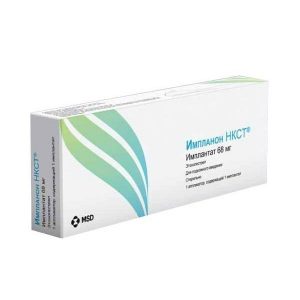Description
Release form
film-coated tablets
Packing
28 pcs.
Pharmacological action
Lactinet is a progestogen-containing contraceptive for oral use, the active substance of which is desogestrel. Like other hormonal contraceptives, which exclusively include progestogen as an active ingredient, Lactinet can be taken by women during breastfeeding, as well as in the presence of contraindications to estrogen or unwillingness to use estrogen-containing contraceptives.
Unlike other gestagenic contraceptives, the contraceptive effect of the drug Lactinet is explained by the inhibition of the ovulation process, which is confirmed by the absence of an ovulatory follicle during ultrasound examination and the absence of an increase in the values of luteotropic hormone (LH) and progesterone in the blood serum in the middle of the menstrual cycle. At the same time, desogestrel, like other progestogens, has the property of increasing the viscosity of cervical mucus, preventing the progress of sperm.
The Pearl Index (an indicator reflecting the pregnancy rate in 100 women during the year of contraception) is 0.4, which is comparable to the use of combined hormonal contraceptives for oral use. The use of the drug Lactinet leads to a decrease in the content of estradiol in blood plasma to values corresponding to the early follicular phase. Progestogens affect carbohydrate and lipid metabolism.
Pharmacokinetics
Absorption
When taken orally, desogestrel is rapidly absorbed. The average maximum concentration in serum is reached after 1.8 hours (Tmax) after taking the pill. The bioavailability of etonogestrel is about 70%.
Distribution in the body
Etonogestrel binds to plasma proteins in 95.5-99%, mainly with albumin and to a lesser extent with sex hormone binding globulin (SHBG).
Metabolism
Desogestrel is metabolized by the hydroxylation and dehydrogenation to the active metabolite etonogestrel. Etonogestrel is metabolized by the formation of sulfate and glucuronide conjugates.
Elimination from the body
The average half-life of etonogestrel is about 30 hours, as with a single, and multiple admission. Equilibrium plasma concentrations are established after 4-5 days. Etonogestrel and its metabolites are excreted by the kidneys and through the intestines (in a ratio of 1.5: 1) in the form of free steroids and conjugates.
In nursing mothers, etonogestrel is excreted in breast milk in a milk / serum ratio of 0.37-0.55. Thus, with an approximate consumption of mother’s milk in an amount of 150 mg / kg / day, a newborn can receive 0.01-0.05 μg of etonogestrel per kg of body weight per day.
Indications
Contraception.
Contraindications
Present or history of venous thromboembolism (including deep vein thrombosis of the lower extremities, pulmonary embolism).
Severe liver disease currently or history (until normalization of liver function).
Current liver failure or history.
Identified or suspected malignant hormone-dependent tumors (including breast cancer).
liver cancer.
Vaginal bleeding of unknown etiology.
Established or suspected pregnancy.
Hypersensitivity to desogestrel or any other component of the drug.
Lactose intolerance, lactase deficiency, glucose-galactose malabsorption.
Long-term immobilization, incl. associated with an operation or disease (risk of venous thromboembolism).
Precautions:
Resistant arterial hypertension, developing while taking the drug, including the ineffectiveness of antihypertensive therapy.
Chloasma, especially with a history of chloasma during pregnancy.
Diabetes mellitus (due to the possible effects of progestogens on peripheral insulin resistance and glucose tolerance).
porphyria.
Systemic lupus erythematosus (SLE).
Herpes (a history of pregnancy).
Use during pregnancy and lactation
Pregnancy
During pregnancy, the use of the drug is contraindicated.
In preclinical studies. with the introduction of very high doses of progestogen, masculinization of the female fetus was observed.
In epidemiological studies, there was no increased risk of teratogenic effects and birth defects in children whose mothers took oral hormonal contraceptives before pregnancy or unintentionally in the early stages of pregnancy.
Lactation
Like other drugs containing only progestogen, Lactinet ® does not affect the quality and quantity of breast milk, but a small amount of desogestrel metabolite (etonogestrel) is excreted in human milk and is approximately 0.01-0.05 μg / kg / day (with the amount of breast milk consumed 150 ml / kg / day). The results of a 7-month follow-up did not reveal increased risks for breast-fed children when assessing their growth, psychomotor and physical development.
Nevertheless, careful dynamic monitoring of the development and growth of the baby during breastfeeding is necessary if a woman uses the drug Lactinet ® for contraception.
Special instructions
If there is any condition or risk factor, the doctor must correlate the risk and benefit of using Lactinet ® individually for each woman before starting hormonal contraception. In the event of any undesirable effect or risk factor, it is necessary to notify the attending physician immediately to resolve the issue of the appropriateness of further administration of the drug.
Women with diabetes should be closely monitored during the first months of using Lactinet ®.
Reception Lactinet ® reduces the content of serum estradiol to the value corresponding to the early follicular phase.
The protective effect of traditional progestogen-only contraceptives in terms of preventing ectopic pregnancy is not as pronounced as that of combined oral contraceptives, which is associated with relatively frequent ovulation when taking only progestogen-containing drugs.
Although Lactinet ® generally inhibits ovulation, the possibility of an ectopic pregnancy should be borne in mind with a differential diagnosis with the development of amenorrhea or abdominal pain in a woman.
Chloasma can sometimes occur, especially in women with a history of pregnant chloasma. Women with a tendency to chloasma should avoid solar and ultraviolet radiation while taking Lactinet ®.
Patients with lactose intolerance should be aware that one film-coated Lactinet ® tablet contains 67.445 mg of lactose monohydrate. Patients with rare hereditary diseases such as lactose intolerance, lactase deficiency or glucose-galactose malabsorption should not take the drug.
Influence on the ability to drive a car or other working mechanisms
Does not affect the ability to drive a car and working mechanisms.
Composition of
Each tablet contains:
Active ingredient:
desogestrel 0.075 mg
Excipients:
composition of the tablet core:
DL -? – tocopherol,
silica, sarlkrldkpc, srdlpkldp, povidone K30.
lactose monohydrate
shell composition:
opadry II white (titanium dioxide (EI71). C1 77891, talc, macrogol 3000, polyvinyl alcohol).
Dosage and administration of
In the absence of previous use of hormonal contraceptives (during the last month), tablets are taken from the first day of the menstrual cycle, one tablet per day, possibly at the same time of day, following the direction indicated on the package, so that the interval between taking two tablets is 24 hours, if necessary with a small amount of liquid. This drug does not require a break in admission. Each subsequent packaging should begin immediately after the previous one.
First use of
Women, which in the previous month do NOT take oral contraceptives:
The first pill should be started on the first day of the menstrual cycle (menstruation). In this case, the use of additional methods of contraception is not required.
You can start taking pills from the 2nd to 5th day of your period, but in this case in the first cycle you need to use additional methods of contraception in the first 7 days of taking the tablets.
Women who switch from another combined oral contraceptive (CCP) to Lactinet ®
If possible, the day after taking the last pill of the previous CCP. In this case, the use of additional methods of contraception is not required.
Women who are switching from monocomponent preparations containing only progestogen (mini-drinks, injections, implants or intrauterine contraceptives that release progestogen)
If you switch from mini-pill, you can start taking the drug on any day in the case of injections – on the day when the next injection should be done in the case of an implant – on the day after its removal.
In all these cases, the use of barrier methods of contraception during the first 7 days is recommended.
Taking the drug after an abortion in the first trimester of pregnancy
After an abortion in the first trimester of pregnancy, it is recommended that you start taking the drug immediately after the abortion, and in this case there is no need to use additional methods of contraception.
Taking the drug after childbirth, or after termination of pregnancy in the second trimester
Administration of the drug begins no earlier than 21-28 days after termination of pregnancy in the second trimester or after childbirth. If you intend to start taking the drug later, then you must use the barrier method of contraception for the first 7 days. In addition, if unprotected sexual intercourse took place before starting the use of the drug, it is necessary to exclude pregnancy or postpone the start of taking the drug on the first day of the next menstruation (when the menstrual cycle is restored).
Missed (forgotten) tablets
Contraceptive effectiveness decreases if more than 36 hours have elapsed between doses of the two tablets. If the break does not exceed 12 hours, the contraceptive effect is not reduced, and the use of an additional contraceptive method is not required.
Take the rest of the pills as usual.
If there is more than a 12-hour hiatus, the contraceptive effect may be reduced.
To achieve effective blocking of the hypothalamic-pituitary-ovarian system, it is necessary to take the drug daily for 7 days. Thus, with a break of more than 12 hours, the drug is continued in normal mode, however, in the next 7 days it is necessary to use additional (barrier) methods of contraception. If the pill was missed in the first week of the drug and in the previous 7 days there was unprotected sexual intercourse, then the probability of pregnancy can not be ruled out.
Measures for vomiting
If vomiting develops within 3 4 hours after taking the pill, the pill is not completely absorbed. In this case, you should do the same as in the case of missed tablets. The necessary tablet (necessary tablets) should be replenished from another package.
Observation of
Despite taking the pill regularly, menstruation can occur. If menstruation occurs very often and irregularly, you should consider using another method of contraception. If the disorder persists, the organic cause must be ruled out.
Tactics for amenorrhea that occurred during the use of the drug depend on whether the tablets were taken in accordance with the instructions or not, a pregnancy test may be required.
If pregnancy occurs, the drug should be discontinued.
It must be remembered that taking Lactinet ® does not protect against HIV infection (AIDS) and other diseases, sexually transmitted.
Side effects of
The most common adverse effect reported in clinical trials has been irregular menstruation. Up to 50% of women who used desogestrel noted acyclic spotting: in 20-30% of women, menstruation becomes more frequent, while in others 20% – more rare or may even completely stop. Menses may also become longer.
After several months of taking the drug, menstruation tends to become less frequent. Informing the doctor, monitoring by the doctor, as well as the use of the menstrual diary can increase compliance with treatment with the drug.
The following are undesirable effects that have an established, probable, or possible association with the use of the drug.
In the event that any of the following conditions / risk factors is observed, you should carefully weigh the expected benefits and risk of using a contraceptive when consulting with your doctor over the entire period of contraception. When appearing, amplification, changes in any of the following conditions / risk factors, the patient should immediately consult a doctor to decide on the possibility of further use of the drug.
Often – acne, nausea, mood changes, decreased libido, breast tenderness, menstrual irregularities, headache, weight gain.
Infrequently – alopecia, fatigue, vomiting, discomfort when wearing contact lenses, vaginitis, dysmenorrhea, ovarian cysts.
Rarely – redness of the skin, rash, urticaria, erythema nodosum.
Although a reliable association with the administration of gestagens has not been established, cholestatic jaundice, pruritus, cholelithiasis, chorea, herpes in pregnant women, otosclerosis, deafness, and the development of hemolytic-uremic syndrome are possible with their administration.
Drug interactions
The simultaneous use of drugs, inducers of microsomal liver enzymes, can cause breakthrough bleeding and a decrease in the contraceptive effect of the drug. Such drugs are hydantoin derivatives (including phenytoin, rifabutin, barbiturates, primidone, carbamazepine and rifampicin, as well as oxcarbazepine, topiramate, felbamate and griseofulvin. There have been no specialized studies on the interaction of desogestrel with other drugs. Micro liver maximal induction. is achieved no earlier than 2-3 weeks after the start of the use of the corresponding inductor up to 4 weeks. after its cancellation.
Antibiotics (e.g. ampicillin and tetracycline) reduce the effectiveness of oral contraceptives.
Women taking medications that induce microsomal liver enzymes should be advised of the temporary additional use of barrier or other non-hormonal methods of contraception.
With the simultaneous use of the above drugs with desogestrel, it is recommended to use the barrier method of contraception throughout the course of treatment and for 7 days (for rifampicin – 28 days after the end of therapy.
In the treatment of activated carbon, steroid absorption, and, therefore, contraceptive effectiveness, In this case, you should adhere to the recommendations given in the “Dosage regimen” section on the missed drug intake.
overdose
Symptoms: nausea, vomiting, bleeding / bleeding from the vagina.
Treatment: no specific antidote, treatment symptomatic.
Storage conditions
Store in the original package at 25 ° C or less.
Shelf life
3 years.
Deystvuyushtee substance
Desogestrel
Terms and conditions
prescription
Dosage form
tablets
Possible product names
LACTINET 0,000075 N28 TABLE P / O
Lactinet 0.075mg Tab. cover captivity. about. X28
Lactinet tab p / o 0.075mg x 28
Lactinet tab p / o 75mkg N28
LACTINET TAB. P.P.O. 75MKG No. 28
Gedeon Richter Vengriya




